
New York

These forward-thinking states are demonstrating the wide variety of options for policymakers who want to raise more from the wealthiest people, rein in corporate tax avoidance, create fair tax codes and build strong communities.
New York: Who Pays? 7th Edition
January 9, 2024 • By ITEP Staff
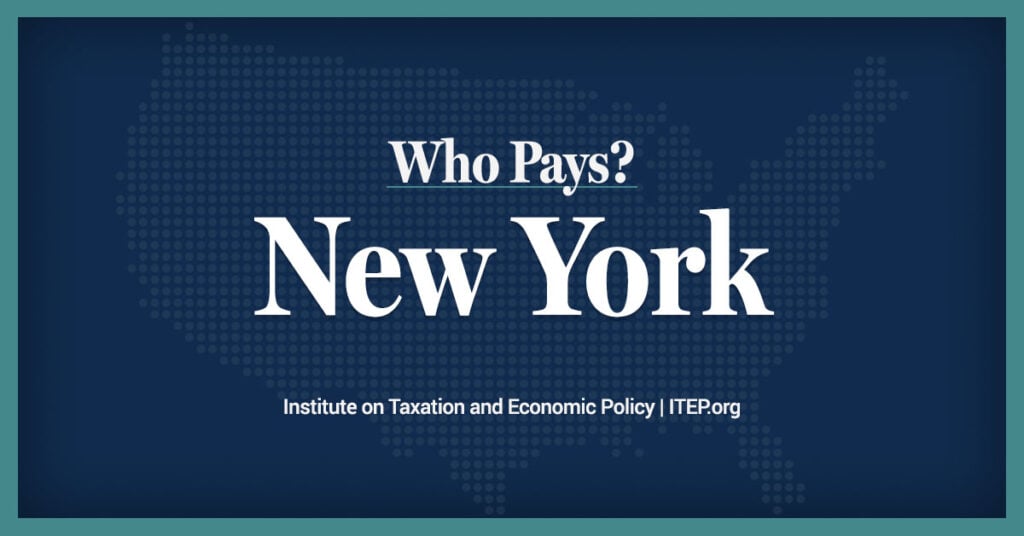
New York Download PDF All figures and charts show 2024 tax law in New York, presented at 2023 income levels. Senior taxpayers are excluded for reasons detailed in the methodology. Our analysis includes nearly all (99.9 percent) state and local tax revenue collected in New York. State and local tax shares of family income Top […]
New Jersey, New York, and Connecticut Should Keep Corporate Taxes Strong, Extend Surcharges
February 28, 2023 • By Marco Guzman

At a time when corporations are seeing record profits while not paying their fair share of federal taxes, state corporate income taxes can and should play a role in raising sustainable revenue and adding progressivity to state tax codes. Right now, lawmakers in New Jersey, New York, and Connecticut have a unique opportunity to extend targeted tax changes that have raised billions of dollars from profitable corporations for meaningful public investments.
Fiscal Policy Institute: Inequality in New York & Options for Progressive Tax Reform
November 11, 2022
Income statistics have long shown that the top earners in New York State earn relatively more than their counterparts elsewhere in the U.S. Income inequality alone, however, provides an incomplete picture of the wealthiest households’ economic resources. In order to understand real economic power, we have to look at households’ wealth (their total net assets). […]
Does New York’s Cannabis Tax Idea Offer a Glimpse of the Future?
February 9, 2021 • By Carl Davis

Taxing cannabis won’t end New York’s budget difficulties, but a potency tax could bring New York a more sustainable stream of cannabis tax revenue than we see in most states. It could also have significant benefits for cannabis consumers.
Fiscal Policy Institute: Unemployment Insurance Taxes Paid for Undocumented Workers in NYS
May 14, 2020
In the midst of a pandemic, there has been a growing call for undocumented immigrants, who make up five percent of the New York State labor force, to be covered by some form of unemployment insurance. What is often overlooked in discussions of unemployment insurance is the extent to which undocumented immigrants are already part […]

Today Amazon announced major expansions in New York and Virginia, where it intends to hire up to 50,000 full-time employees. The announcement marks the culmination of a highly publicized search that lasted more than a year and involved aggressive courting of the company by cities across the nation. The following are three tax-related observations on the announcement.
New York: Who Pays? 6th Edition
October 17, 2018 • By ITEP Staff
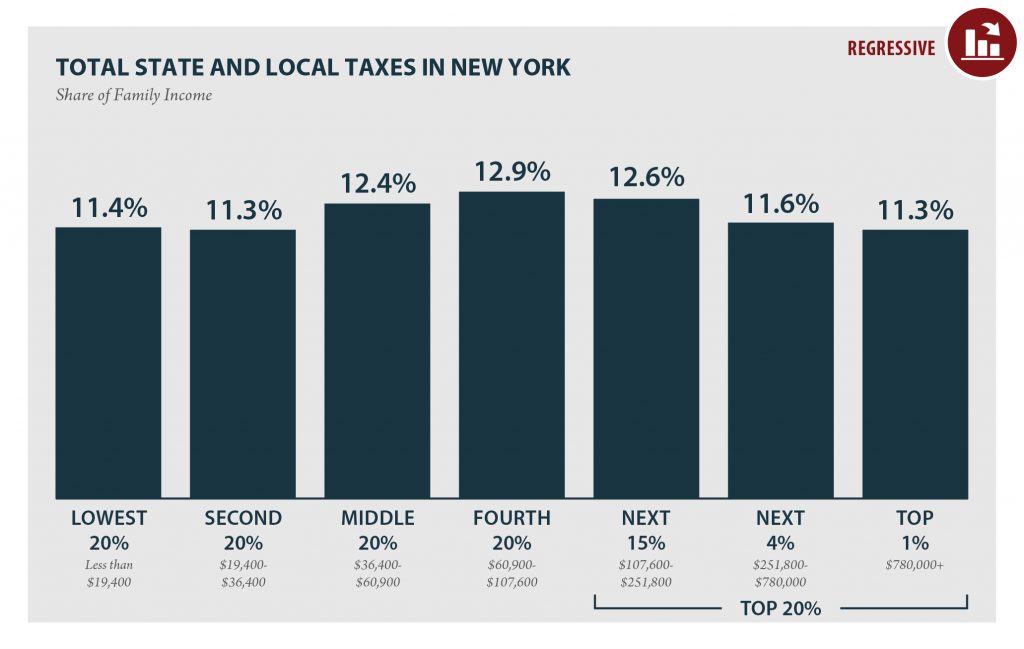
NEW YORK Read as PDF NEW YORK STATE AND LOCAL TAXES Taxes as Share of Family Income Top 20% Income Group Lowest 20% Second 20% Middle 20% Fourth 20% Next 15% Next 4% Top 1% Income Range Less than $19,400 $19,400 to $36,400 $36,400 to $60,900 $60,900 to $107,600 $107,600 to $251,800 $251,800 to $780,000 […]
Tax Cuts 2.0 – New York
September 26, 2018 • By ITEP Staff
The $2 trillion 2017 Tax Cuts and Jobs Act (TCJA) includes several provisions set to expire at the end of 2025. Now, GOP leaders have introduced a bill informally called “Tax Cuts 2.0” or “Tax Reform 2.0,” which would make the temporary provisions permanent. And they falsely claim that making these provisions permanent will benefit […]
How the Final GOP-Trump Tax Bill Would Affect New York Residents’ Federal Taxes
December 16, 2017 • By ITEP Staff
The final tax bill that Republicans in Congress are poised to approve would provide most of its benefits to high-income households and foreign investors while raising taxes on many low- and middle-income Americans. The bill would go into effect in 2018 but the provisions directly affecting families and individuals would all expire after 2025, with […]
How the House and Senate Tax Bills Would Affect New York Residents’ Federal Taxes
December 6, 2017 • By ITEP Staff

The House passed its “Tax Cuts and Jobs Act” November 16th and the Senate passed its version December 2nd. Both bills would raise taxes on many low- and middle-income families in every state and provide the wealthiest Americans and foreign investors substantial tax cuts, while adding more than $1.4 trillion to the deficit over ten years. The graph below shows that both bills are skewed to the richest 1 percent of New York residents.
Fiscal Policy Institute: Dream Act: What’s At Stake for New York
December 1, 2017
There are 76,000 young immigrants who were potentially eligible for DACA that call New York home. They currently contribute a total of $115 million to local and state taxes annually through sales and excise taxes, property taxes and income tax. Read more
House Tax Plan Offers an Exceptionally Bad Deal for California, New York, New Jersey, and Maryland
November 14, 2017 • By Carl Davis
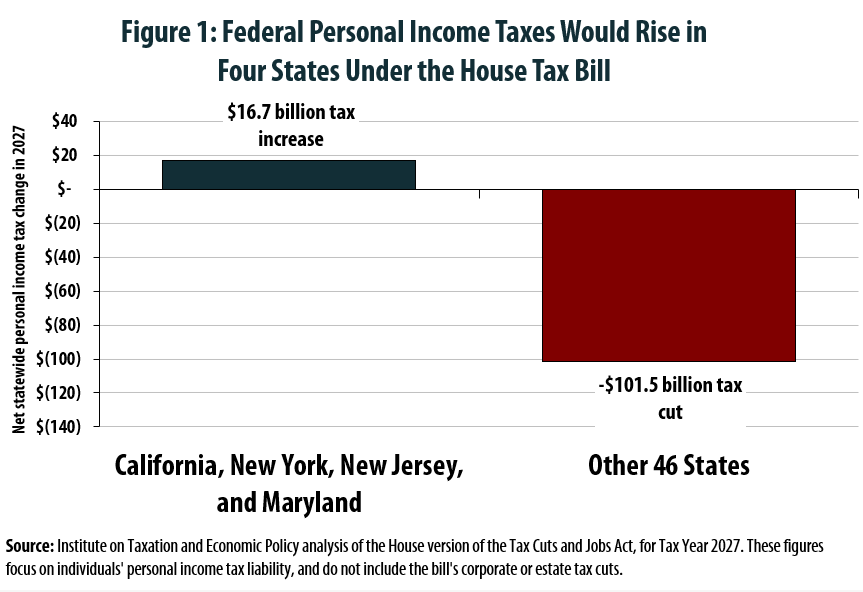
An ITEP analysis reveals that four states would see their residents pay more in aggregate federal personal income taxes under the House’s Tax Cuts and Jobs Act. While some individual taxpayers in every state would face a tax increase, only California, New York, Maryland, and New Jersey would see such large increases that their residents’ overall personal income tax payments rise when compared to current law.
How the Revised Senate Tax Bill Would Affect New York Residents’ Federal Taxes
November 14, 2017 • By ITEP Staff
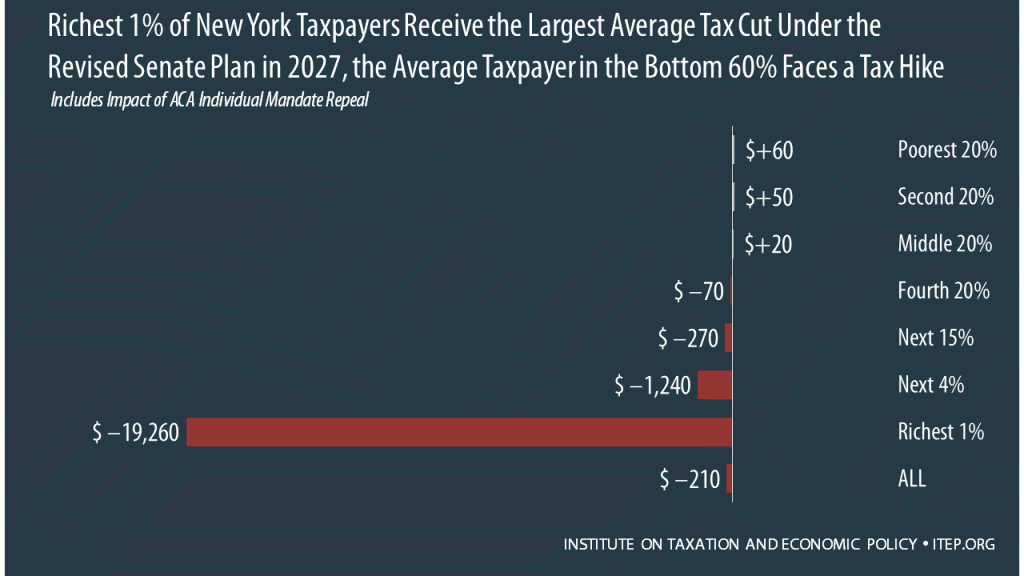
The Senate tax bill released last week would raise taxes on some families while bestowing immense benefits on wealthy Americans and foreign investors. In New York, 38 percent of the federal tax cuts would go to the richest 5 percent of residents, and 19 percent of households would face a tax increase, once the bill is fully implemented.
How the House Tax Proposal Would Affect New York Residents’ Federal Taxes
November 6, 2017 • By ITEP Staff
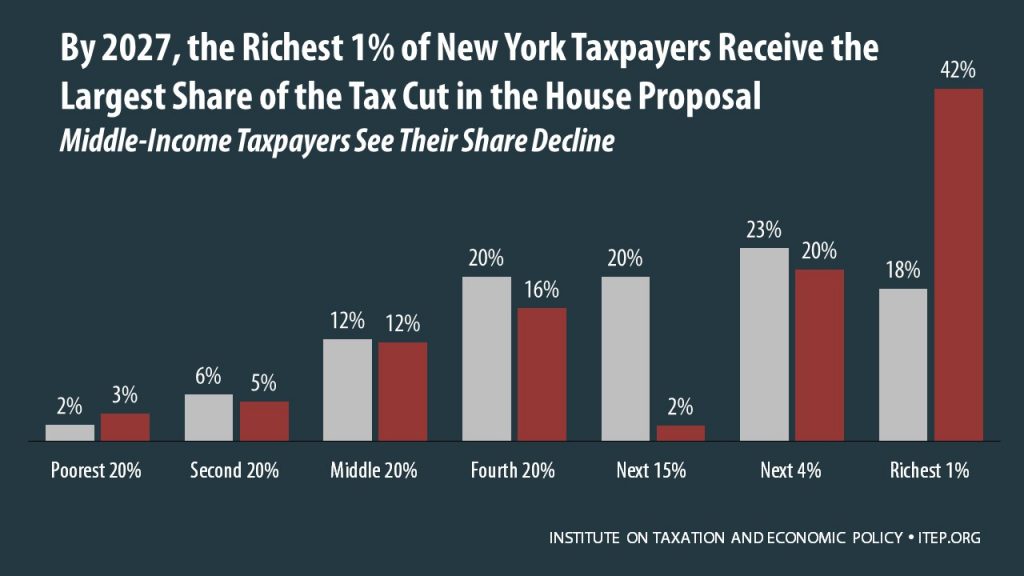
The Tax Cuts and Jobs Act, which was introduced on November 2 in the House of Representatives, includes some provisions that raise taxes and some that cut taxes, so the net effect for any particular family’s federal tax bill depends on their situation. Some of the provisions that benefit the middle class — like lower tax rates, an increased standard deduction, and a $300 tax credit for each adult in a household — are designed to expire or become less generous over time. Some of the provisions that benefit the wealthy, such as the reduction and eventual repeal of the estate…
GOP-Trump Tax Framework Would Provide Richest One Percent in New York with 84.0 Percent of the State’s Tax Cuts
October 4, 2017 • By ITEP Staff
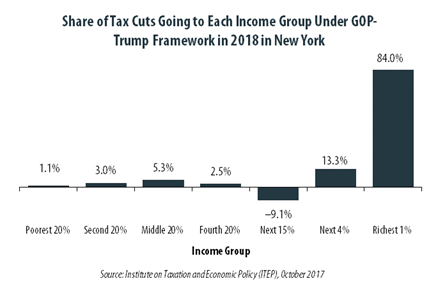
The “tax reform framework” released by the Trump administration and congressional Republican leaders on September 27 would not benefit everyone in New York equally. The richest one percent of New York residents would receive 84.0 percent of the tax cuts within the state under the framework in 2018. These households are projected to have an income of at least $872,200 next year. The framework would provide them an average tax cut of $103,660 in 2018, which would increase their income by an average of 3.2 percent.
In New York 57.9 Percent of Trump’s Proposed Tax Cuts Go to People Making More than $1 Million
August 17, 2017 • By ITEP Staff
A tiny fraction of the New York population (0.6 percent) earns more than $1 million annually. But this elite group would receive 57.9 percent of the tax cuts that go to New York residents under the tax proposals from the Trump administration. A much larger group, 44.8 percent of the state, earns less than $45,000, but would receive just 3.6 percent of the tax cuts.
Trump Tax Proposals Would Provide Richest One Percent in New York with 66.9 Percent of the State’s Tax Cuts
July 20, 2017 • By ITEP Staff
Earlier this year, the Trump administration released some broadly outlined proposals to overhaul the federal tax code. Households in New York would not benefit equally from these proposals. The richest one percent of the state’s taxpayers are projected to make an average income of $3,234,000 in 2018. They would receive 66.9 percent of the tax cuts that go to New York’s residents and would enjoy an average cut of $176,680 in 2018 alone.
Fiscal Policy Institute: Immigrant Youth Add $140 Million to New York Tax Revenues
April 25, 2017
The report, conducted by the Institute on Taxation and Economic Policy and co-released in New York by the Fiscal Policy Institute, focuses on the executive order known as Deferred Action for Childhood Arrivals, or DACA. The executive order first went into effect in 2012, and in New York State, of the estimated 820,000 undocumented immigrants, about 76,000 are eligible for DACA.
Fiscal Policy Institute: Economic Contribution, Taxes Paid, and Occupations of Unauthorized Immigrants in New York State
April 3, 2017
There is a widespread misconception that unauthorized immigrants do not pay taxes. Yet, a careful national study prepared by the Institute on Taxation and Economic Policy—and coreleased in New York by the Fiscal Policy Institute with this report—finds that unauthorized immigrants currently pay $1.1 billion in state and local taxes in New York. Read more […]
Poughkeepsie Journal: The state of Hudson Valley immigration
January 14, 2017
“Whatever one’s political view, the fate of New York’s immigrant population could have a significant impact on state and local economies. Undocumented immigrants make up a large portion of the workforce in New York industries like construction, landscaping, food and cleaning services, and farming operations upstate and on Long Island. The non-profit Institute on Taxation […]
Nassau Herald: Lessons learned about Long Island immigrants
December 23, 2016
“And, according to the FPI, “Like U.S.-born residents, immigrants pay a lot in property taxes.” Seventy-three percent of Long Island immigrants live in owner-occupied homes, and 40 percent of them pay more than $10,000 a year in property taxes to support local schools and services. The FPI could not say precisely how much unauthorized immigrants […]
Politifact: Most taxes are lower since Cuomo was elected
December 20, 2016
“Property taxes statewide continue to rise despite a state imposed cap. Most municipalities are not able to raise property taxes more than 2 percent without voter approval. The Department of Budget says the property tax bill for a typical taxpayer is more than the state income tax amount. A report from the Institute on Taxation […]
Village Voice: Why Cuomo’s Hopes for Trump Infrastructure Cash Could Crumble
December 7, 2016
“And transportation experts warn that plenty of worthy projects would likely fall by the wayside if P3s were the only option. “We’re not going to have private companies filling our potholes or expanding our bus system, because those things aren’t profitable,” says Carl Davis, research director at the D.C.-based Institute on Taxation and Economic Policy. […]
Poughkeepsie Journal: Tax exempt: Millions in breaks for IDAs, but few jobs
October 31, 2016
“Matt Gardner, executive director of the Institute on Taxation and Economic Policy, a Washington, D.C., nonprofit research group, agreed that New York has done a good job of keeping tabs on tax breaks for development projects. What it hasn’t done is slow down on giving them away.” Read more
